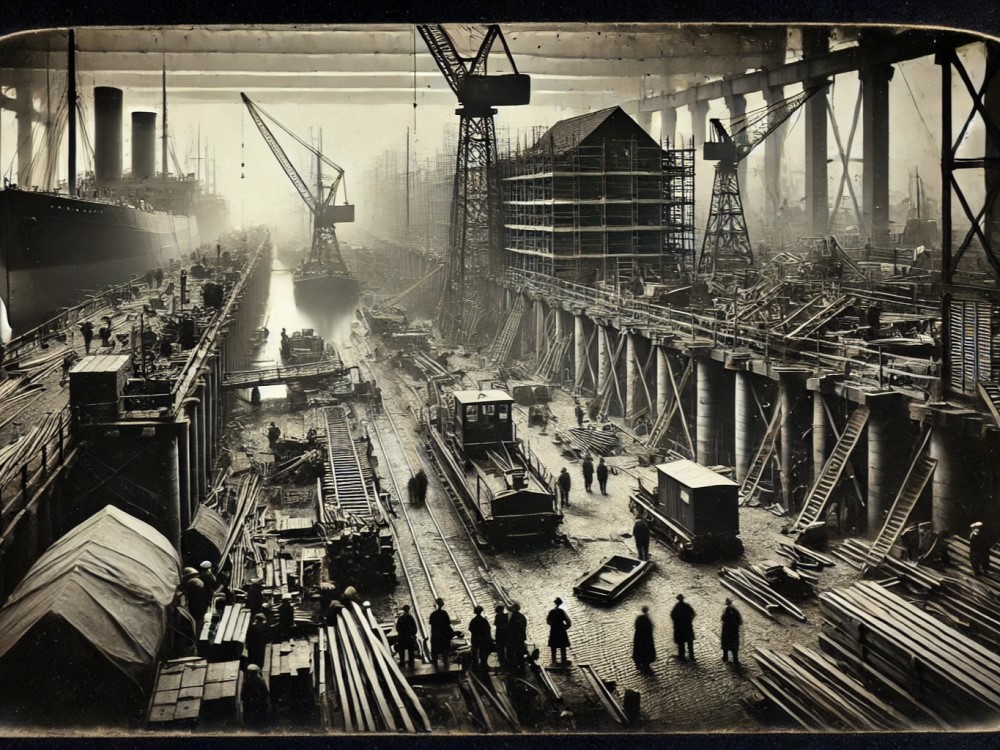
Tech and Business Scene in Canary Wharf
Canary Wharf, a bustling hub of commerce and technology, stands as a testament to London’s continuous evolution. This area, once known for its maritime activities, has transformed into a modern metropolis brimming with skyscrapers, cutting-edge businesses, and a vibrant tech scene. Its journey from a historic dockyard to a leading financial district underscores its pivotal role in the global business landscape.
The transformation of Canary Wharf is deeply rooted in its past. The area’s development as a major financial center is a relatively recent phenomenon, but its maritime roots stretch back centuries. Understanding Canary Wharf’s maritime history provides valuable context for its current status. The docks, once a gateway for goods and trade, have given way to towering office buildings that house some of the world’s most influential corporations.
Today, Canary Wharf is synonymous with iconic architecture and cutting-edge design. The skyline, dominated by towering structures, reflects the area’s modernity and its importance as a business hub. Exploring Canary Wharf’s iconic buildings reveals the architectural marvels that define the district. These buildings are not just office spaces; they symbolize the power and innovation that drive the global economy.
Navigating through Canary Wharf is an experience in itself. The area is well-connected, making it easily accessible for professionals and visitors alike. Efficient getting around Canary Wharf is facilitated by a robust transportation network, including the London Underground, Docklands Light Railway (DLR), and numerous bus routes. This connectivity ensures that the district remains a convenient and attractive location for businesses.
The commercial vibrancy of Canary Wharf is further enhanced by its shopping and dining options. The district is home to an array of high-end retail stores, providing ample opportunities for both window shopping and luxury purchases. Exploring shopping at Canary Wharf reveals a plethora of shops that cater to the sophisticated tastes of its clientele. From fashion boutiques to electronics stores, the shopping experience here is diverse and upscale.
Dining in Canary Wharf is equally impressive, with a variety of restaurants offering culinary delights from around the world. The dining scene is designed to cater to the diverse tastes of the business community and visitors, providing everything from quick bites to gourmet meals. Discovering the best spots for dining in Canary Wharf ensures that there are options to suit every palate and occasion, whether it’s a business lunch or an after-work dinner.
Beyond the commercial and culinary attractions, Canary Wharf also boasts a range of hidden gems that add to its charm. These lesser-known spots offer unique experiences and insights into the district’s character. Uncovering the hidden gems in Canary Wharf can lead to discovering quiet corners, artistic installations, and historical remnants that provide a break from the hustle and bustle of the business world.
Amidst the skyscrapers and commercial activity, Canary Wharf offers tranquil green spaces that provide a respite from the urban environment. These parks and gardens are meticulously maintained, offering a peaceful retreat for those looking to relax or enjoy outdoor activities. Exploring Canary Wharf’s parks and green spaces highlights the district’s commitment to incorporating nature into its urban landscape, making it a more livable and pleasant area for everyone.
In addition to parks, the waterways of Canary Wharf offer unique recreational opportunities. Engaging in water activities in Canary Wharf, such as kayaking and paddleboarding, provides a different perspective on the area and adds to the diverse range of activities available. These water-based activities complement the urban environment, offering a blend of adventure and relaxation.
Canary Wharf is a dynamic and multifaceted district that has successfully transitioned from its historical roots to become a global center for business and technology. Its well-planned infrastructure, iconic architecture, and vibrant commercial scene make it an attractive destination for professionals and visitors alike. As the tech and business sectors continue to evolve, Canary Wharf stands as a prime example of how innovation and tradition can coexist, creating a thriving environment that supports growth and progress.
Historical Background and Transformation

The history of Canary Wharf is deeply rooted in London’s maritime heritage. Located in the Isle of Dogs, it was originally one of the busiest docks in the world during the 19th and early 20th centuries. However, the decline of the dock industry in the 1960s and 1970s left the area in a state of disrepair. The landscape began to change dramatically in the late 1980s when a major redevelopment project was initiated to transform the derelict docks into a modern business district.
The vision for Canary Wharf was ambitious: to create a financial center that could rival the City of London. With significant investment from private developers and support from the government, the transformation began. The construction of iconic skyscrapers like One Canada Square, which was the tallest building in the UK until 2010, marked the beginning of Canary Wharf’s rise as a financial powerhouse. Major banks, including HSBC and Citigroup, established their headquarters here, attracting a skilled workforce and boosting the area’s economic profile.
The early 2000s saw further development, with the addition of more office spaces, retail outlets, and residential areas. However, the global financial crisis of 2008 highlighted the need for diversification. Recognizing the potential for growth in the technology sector, Canary Wharf Group (the primary development and management company for the area) began to pivot towards tech and innovation. This strategic shift laid the foundation for Canary Wharf’s current status as a tech and business hub.
Rise of the Tech Industry
The rise of the tech industry in Canary Wharf can be attributed to several key factors, including strategic initiatives, infrastructure development, and a supportive business environment. One of the most significant developments was the establishment of Level39 in 2013. Level39, Europe’s largest technology accelerator for fintech, cybersecurity, and retail technology companies, has played a pivotal role in attracting startups and tech firms to the area.
Located in One Canada Square, Level39 provides a unique ecosystem for tech companies to grow and thrive. It offers state-of-the-art office spaces, access to investors, mentorship programs, and a collaborative community of like-minded entrepreneurs. The success of Level39 has not only cemented Canary Wharf’s reputation as a tech hub but has also spurred the growth of a broader tech ecosystem in the area.
In addition to Level39, the introduction of smart city initiatives has further enhanced Canary Wharf’s appeal to tech companies. The district has embraced cutting-edge technologies such as IoT (Internet of Things), big data analytics, and AI (artificial intelligence) to create a more efficient and sustainable urban environment. Projects like the Connected Digital Economy Catapult and the Smart City Demonstrator have showcased how technology can be integrated into urban planning and development, making Canary Wharf a model for smart cities worldwide.
The presence of major tech giants has also contributed to the area’s growth. Companies like IBM, Infosys, and Intel have established a significant presence in Canary Wharf, leveraging the district’s infrastructure and business-friendly environment. The synergy between established tech firms and startups has created a dynamic and innovative ecosystem, driving further growth and attracting talent from around the globe.
Business Environment and Infrastructure

The business environment in Canary Wharf is characterized by its state-of-the-art infrastructure, strategic location, and a range of amenities designed to support the needs of modern businesses. The district’s architecture is a blend of iconic skyscrapers, contemporary office spaces, and green public areas, creating an environment that is both functional and aesthetically pleasing.
One of the key advantages of Canary Wharf is its connectivity. The district is well-served by public transportation, including the London Underground, the Docklands Light Railway (DLR), and several bus routes. The Jubilee Line provides direct access to central London, while the DLR connects Canary Wharf to the City of London and beyond. The introduction of the Elizabeth Line (Crossrail) has further enhanced connectivity, reducing travel times to key destinations and making Canary Wharf even more accessible.
In addition to excellent transportation links, Canary Wharf boasts world-class office spaces equipped with the latest technology and amenities. Buildings like One Canada Square, the HSBC Tower, and the Citigroup Centre offer flexible office solutions, from traditional office suites to coworking spaces and serviced offices. This flexibility allows businesses of all sizes to find suitable premises, from multinational corporations to startups and small enterprises.
The district’s amenities extend beyond office spaces. Canary Wharf is home to a wide range of retail outlets, restaurants, cafes, and entertainment venues, providing a vibrant and diverse environment for both work and leisure. The presence of green spaces, such as Jubilee Park and Westferry Circus Gardens, offers employees a place to relax and unwind, contributing to a positive work-life balance.
Furthermore, Canary Wharf has invested in creating a sustainable and resilient business environment. The district’s commitment to sustainability is evident in its green building practices, energy-efficient infrastructure, and initiatives to reduce carbon emissions. The integration of smart technologies and sustainable practices has positioned Canary Wharf as a leader in urban sustainability, attracting businesses that prioritize environmental responsibility.
Key Players and Innovations
The tech and business scene in Canary Wharf is driven by a diverse range of key players, from global corporations to innovative startups. These organizations have contributed to the district’s dynamic ecosystem, fostering a culture of innovation and collaboration.
Level39 stands out as a central player in the tech ecosystem. Since its inception, Level39 has supported over 1,200 tech startups and scale-ups, providing them with the resources and network needed to grow and succeed. Companies based at Level39 have access to a range of services, including mentorship from industry experts, access to funding, and opportunities to collaborate with other tech firms. The accelerator’s focus on fintech, cybersecurity, and retail technology has positioned Canary Wharf as a leader in these sectors.
Major financial institutions, such as HSBC, Barclays, and Citigroup, have also played a crucial role in shaping the tech and business landscape. These banks have embraced digital transformation, investing heavily in fintech and digital innovation. Barclays, for example, established its fintech innovation lab, Rise, in Canary Wharf, providing a platform for startups to develop and test new financial technologies. The collaboration between traditional financial institutions and tech startups has driven innovation and created new opportunities for growth.
Global tech companies have further strengthened Canary Wharf’s position as a tech hub. IBM, with its focus on AI and cloud computing, has contributed to the development of smart city initiatives and digital transformation projects in the area. Intel’s presence has facilitated advancements in IoT and data analytics, supporting the district’s smart infrastructure. Infosys, a leader in IT services and consulting, has established its European headquarters in Canary Wharf, providing a gateway for international tech talent and innovation.
Innovation is also evident in the development of smart city projects. Canary Wharf Group has implemented a range of smart technologies to enhance the district’s infrastructure and services. The Smart City Demonstrator project, for instance, has integrated IoT sensors and data analytics to optimize energy consumption, improve traffic management, and enhance public safety. These initiatives have demonstrated the potential of technology to create more efficient and sustainable urban environments.
The collaboration between these key players has fostered a culture of innovation and experimentation. The exchange of ideas and expertise has led to the development of cutting-edge technologies and solutions that have a global impact. Canary Wharf’s ability to attract and retain top talent, combined with its supportive business environment, ensures that it remains at the forefront of technological innovation.
Future Prospects and Challenges

The future prospects for Canary Wharf’s tech and business scene are promising, driven by ongoing developments, strategic initiatives, and a commitment to innovation. However, the district also faces several challenges that need to be addressed to sustain its growth and maintain its competitive edge.
One of the key areas of focus for the future is the continued development of smart city infrastructure. Canary Wharf Group has outlined plans to expand its smart city initiatives, integrating advanced technologies to enhance urban living and working conditions. This includes the implementation of 5G networks, further integration of IoT devices, and the use of AI to optimize city services. These advancements will not only improve the quality of life for residents and workers but also attract more tech companies and startups to the area.
Another important aspect of Canary Wharf’s future is its role in supporting the digital economy. The district aims to become a global leader in digital innovation, fostering the growth of tech sectors such as fintech, cybersecurity, and AI. Initiatives like the Digital Catapult and the development of digital innovation hubs will provide the necessary infrastructure and support for tech companies to thrive. Collaboration with academic institutions and research organizations will also play a crucial role in driving innovation and talent development.
However, challenges remain, particularly in terms of maintaining a balance between development and sustainability. As Canary Wharf continues to grow, it must ensure that its expansion is environmentally responsible and resilient. This includes addressing issues related to energy consumption, waste management, and carbon emissions. The district’s commitment to sustainability must be upheld through the adoption of green building practices, renewable energy sources, and sustainable urban planning.
Another challenge is the need to foster inclusivity and diversity within the tech and business ecosystem. Ensuring that opportunities are accessible to a diverse range of individuals and businesses is crucial for fostering innovation and creating a vibrant community. Initiatives to support underrepresented groups, promote diversity in hiring, and provide accessible resources for startups will be essential in achieving this goal.
The impact of external factors, such as economic fluctuations and geopolitical changes, also poses challenges to Canary Wharf’s growth. The district must remain adaptable and resilient, leveraging its strengths and mitigating risks to navigate uncertainties. Building strong partnerships with global businesses, governments, and institutions will be vital in maintaining its position as a leading tech and business hub.
Conclusion: Canary Wharf – A Beacon of Innovation and Growth
![]()
Canary Wharf’s evolution from a financial district to a thriving tech and business hub is a remarkable story of transformation and innovation. The district’s strategic initiatives, state-of-the-art infrastructure, and supportive business environment have attracted a diverse range of tech companies, startups, and global corporations. This dynamic ecosystem has fostered a culture of collaboration and experimentation, driving technological advancements and creating new opportunities for growth.
As Canary Wharf continues to evolve, its focus on sustainability, smart city development, and digital innovation will shape its future. The district’s ability to address challenges, embrace diversity, and remain resilient in the face of external factors will be crucial in sustaining its growth and maintaining its competitive edge.
The journey of Canary Wharf is a testament to the power of visionary thinking and strategic planning. By balancing tradition with innovation, the district has not only preserved its rich heritage but also embraced the future of business and technology. Canary Wharf stands as a model for urban development, showcasing how a city can adapt, innovate, and thrive in an ever-changing world.
Looking ahead, Canary Wharf’s commitment to sustainability and smart city initiatives will play a pivotal role in its ongoing success. By integrating cutting-edge technologies and green practices, the district aims to create an environment that is not only economically vibrant but also environmentally responsible. This forward-thinking approach ensures that Canary Wharf remains at the forefront of global urban development, setting standards for others to follow.
In conclusion, Canary Wharf’s transformation highlights the importance of adaptability, innovation, and strategic foresight. Its journey from a traditional financial district to a modern, diversified business hub underscores the district’s resilience and forward-looking vision. As it continues to grow and evolve, Canary Wharf will undoubtedly remain a key player on the global stage, demonstrating how urban areas can successfully navigate the complexities of modern development while fostering a vibrant, inclusive, and sustainable community.





